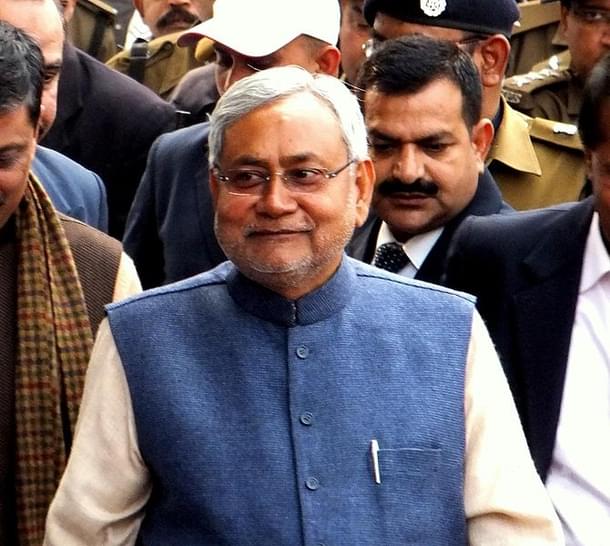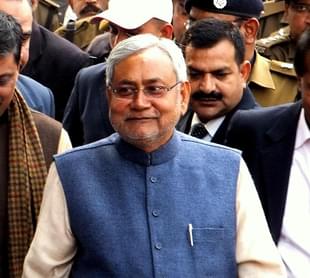Politics
Decoding Nitish Kumar’s Politics: What Works For Him, And What Does Not
R Jagannathan
Jul 27, 2017, 04:24 PM | Updated 04:24 PM IST
Save & read from anywhere!
Bookmark stories for easy access on any device or the Swarajya app.


Nitish Kumar’s decision to dump his motley mahagathbandhan and tie the knot again with the Bharatiya Janata Party (BJP) in Bihar, despite couched in the principle of anti-corruption, is actually another demonstration that the ultimate goal of politics is power. Not that power is devoid of principle, but political success needs you to use principle when it is relevant, and keep it in hibernation when it isn’t. This is the secret of the Narendra Modi-Amit Shah brand of politics, where politics and principle are not joined at the hip as inseparable twins.
Nitish Kumar has been a great survivor in politics, but he does seem to have a tendency to make the wrong choices at the right time, and the right choices only when there is no alternative. The current shift away from the Lalu Prasad Yadav-dominated alliance that includes the Congress is closer to the latter: he had no option if he wanted a political future. Given time, the Lalu-Congress combo would have broken up the Janata Dal (United) bloc in the assembly and taken direct control of power. Rashtriya Janata Dal (RJD) and Congress, between them, have 107 MLAs, just 15 short of a majority. Logically, this number could have come only from the JD(U). Nitish Kumar knew he was skating on thin ice. Hence the fresh leap towards the National Democratic Alliance (NDA).
The point worth emphasising is that if Nitish Kumar had made this shift earlier, he would have been in a far stronger position in Bihar and the NDA.
Consider the timing of his moves since 2013, when he famously broke with the NDA when the BJP elevated Narendra Modi to be its prime ministerial nominee. At that time, Nitish Kumar had probably calculated that 2014 will result in a hung parliament, and his break with the BJP will position him for the top job as head of a multi-party “secular” coalition. He misread the nation’s mood completely.
If he had merely made noises about Modi’s rise and retained his ties to the BJP, he would have been sitting pretty, since the BJP would clearly have given him 10-15 seats in the 2014 Lok Sabha polls – and he would have won most of them. In the case of a hung parliament, his numbers would have counted.
In 2014, once his party got a drubbing in the Lok Sabha polls, he again made a wrong move: he resigned, and put Jitan Ram Manjhi as CM – thus ceding power just when he needed to play his political cards better. He forgot another power principle in politics: when you pass on real power to even someone who you consider a stooge, the equation changes. P V Narasimha Rao was put in the PM’s gaddi on the assumption that he did not have a strong political constituency; but once in office, he was his own man, complete with the power of patronage to swing neutrals to his side.
Nitish Kumar thus did not cover himself with glory when he had to seek Lalu Prasad’s backing to forcibly remove Manjhi, a Dalit, from the CM’s post, before the assembly polls in 2015. This ensured that Lalu Prasad got the upper hand, and the assembly polls ensured that the RJD got more seats than Nitish Kumar.
Nitish Kumar’s other mistake was to confuse his benign image with control of a vote bank. He did not understand his own limitations. The reality is that the Muslim vote bank, while grateful to him for breaking with the BJP in 2013, was really on the side of Lalu Prasad and Congress in 2015. It usually swings to the side that seems to have a larger claim to the “secular” tag. Nitish Kumar, who was in bed with the BJP for nearly a decade, could hardly have believed this vote bank would swing towards him for taking on Modi.
Nitish Kumar’s strength is his image as a non-combative and soft-natured politician. This makes him acceptable to many parties, but it does not in any way mean he has the grassroots support to call the shots in any coalition. He probably can’t even deliver the Kurmi vote bank to any coalition he joins. This inability to separate his public image from his real power base is what undid him.
The latest switch, where Nitish Kumar has accepted BJP support to remain in power, is the right move, but it also reduces his room for manoeuvre. He would have been far stronger if he had not misread the political mood in 2013, and had corrected his mistake at the first opportunity after the 2014 Lok Sabha defeat. He was never meant to rule based on Lalu Prasad’s power. If he had to choose between Lalu Prasad and Modi, he could have chosen the latter and gained political clout in the NDA.
As things stand now, his bargaining power with the BJP is lower. However, it is still the right decision from the point of view of electoral arithmetic and political chemistry. With Sushil Kumar Modi, with whom Nitish Kumar has always had a good equation, as his deputy, it is clear that this ganthbandhan will work better for him than the mahagathbandhan he left behind. He will have more leeway to govern and administer the state as he would like to. He may have to abandon his Delhi dreams, but he gets to wear the Patna crown.
To be sure, Nitish Kumar’s decision to break from Lalu Prasad is not something brought on only by the corruption scandals involving members of the latter’s family, including Deputy CM Tejashwi Yadav. He must have been plotting this move for months now, starting with his support for demonetisation, his rush to back Ram Nath Kovind for the presidency, et al. Clearly, Nitish Kumar knew the mahagathbandhan was not his future. Better late than being consigned to the dungheap of history.
The Bihar NDA coalition of 2017 now resembles the Uttar Pradesh one, with the non-Yadav OBCs, upper castes and a section of Dalits now being the coalition’s core vote base. The opposition is essentially the Yadav-Muslim combo.
The 2019 line-up is now clear. The BJP will probably be fighting with a stronger coalition arithmetic behind it. It means giving Nitish Kumar more seats; but what the BJP gives, it will gain in terms of gains on the NDA total.
Jagannathan is former Editorial Director, Swarajya. He tweets at @TheJaggi.





